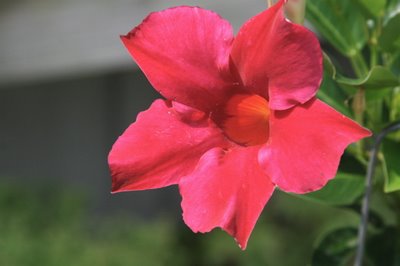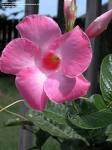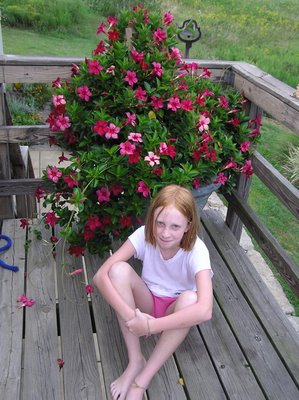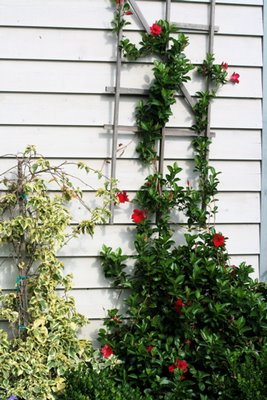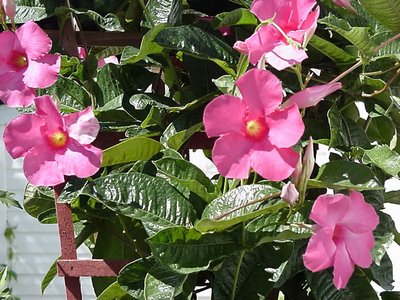Defying Death in the Greenhouse
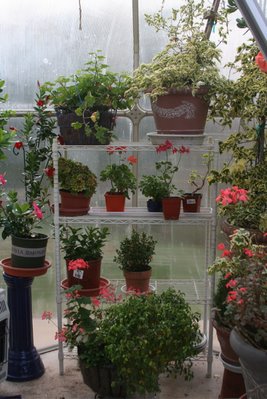 One of my chief methods of beating Old Man Winter at his depressing game is standing in my Garden Pod, breathing the oxygen created by dozens of potted plants. I just went out and took stock. Seven of them I bought, albeit years ago in some cases. All the rest I've propagated from cuttings or been given by friends. So should it be in a greenhouse. It's full of plants I love, plants that bear association with people and places in my life. For an audio musing on this topic, please listen to my NPR commentary, "Rosemary is for Remembrance."
One of my chief methods of beating Old Man Winter at his depressing game is standing in my Garden Pod, breathing the oxygen created by dozens of potted plants. I just went out and took stock. Seven of them I bought, albeit years ago in some cases. All the rest I've propagated from cuttings or been given by friends. So should it be in a greenhouse. It's full of plants I love, plants that bear association with people and places in my life. For an audio musing on this topic, please listen to my NPR commentary, "Rosemary is for Remembrance."Some of the Pod denizens are plants I just couldn't say goodbye to in November, when it finally got seriously cold. They were thriving, and I couldn't let them die. I've been pleasantly surprised by the beauty and floriferous nature of this Rebel chocolate-leaved geranium (pale pink blossoms, on the floor in the photo below). I have to admit that selective breeding does produce some real wonders, like this nearly-perfect geranium. The blossoms hold well without shattering; they're nice and full and round; the leaves are gorgeous, and this creature has not stopped blooming since May. I'm so glad I hauled it in. And I made a cutting, just in case, and it's doing well, too.
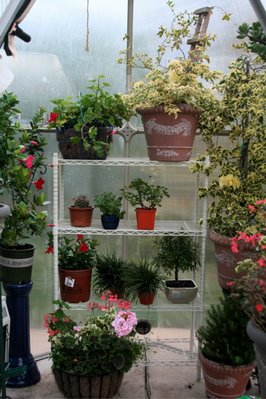 Early Saturday morning, I awoke to the sound of coughing, miserable children, as I had for the last four nights. Both Phoebe and Liam are dreadful ill with sore throats, congestion, headaches, coughs, and fevers. They're marginally better tonight (Monday), but I'm pretty sure this is a viral illness, as it's not responding to the antibiotic they were prescribed. I dose them twice a night with palliatives. I finished my rounds, blearily measuring ibuprofen and cough syrup, and realized that it was cold. Much too cold for 6 AM. I checked the thermostat, 58 degrees. It had been set to 67. I raced to the cookstove, fully awake, and turned on the gas. The ignitor clicked, but the burner didn't light. Oh, crap, oh crap, oh crap, the gas is off. Must move fast now.
Early Saturday morning, I awoke to the sound of coughing, miserable children, as I had for the last four nights. Both Phoebe and Liam are dreadful ill with sore throats, congestion, headaches, coughs, and fevers. They're marginally better tonight (Monday), but I'm pretty sure this is a viral illness, as it's not responding to the antibiotic they were prescribed. I dose them twice a night with palliatives. I finished my rounds, blearily measuring ibuprofen and cough syrup, and realized that it was cold. Much too cold for 6 AM. I checked the thermostat, 58 degrees. It had been set to 67. I raced to the cookstove, fully awake, and turned on the gas. The ignitor clicked, but the burner didn't light. Oh, crap, oh crap, oh crap, the gas is off. Must move fast now.We heat with natural gas, from a well on our land. It comes through an orange plastic pipe from a welljack out at the end of the meadow. Homegrown natural gas is great when it works, and it's free. Consider that for a moment, free heat...when are you all moving to southern Ohio to be my neighbors??
When it cuts off, though, you have to act fast, and you have to know what to do. Bill hurried out to the regulator, pulled the pin, and with a prayer, listened for the hiss that would mean the gas was operative, but just off thanks to condensation in the line (a hazard when temperatures fluctuate wildly in the winter).
My greenhouse is heated with gas. It's a little plastic pod that does not hold heat in the least.
I have two variegated bougainvilleas in that greenhouse who are right below Charlie and my tankful of emperor tetras on the hierarchy of my favorite creatures. Bill gave me the first one for my birthday three years ago. They remind me of Mexico, where in 2005 we had one of the happiest vacations of our married life. They make me happy. They take me back to a frost-free place and time in my life.

I looked at the thermometer. Twenty-two degrees outside.
I put on a coat and went out to the greenhouse, strangely calm and collected, for what was going on in my poor head. Twenty-two degrees inside the Pod. Breath panting, showing in the black night air. Bougainvilleas, geraniums, basil, fuchsia, ficus, cacti, succulents, gardenias, hibiscus, abutilon, heliotrope, mandevillas. None of them hardy, all of them standing at 22 degrees.
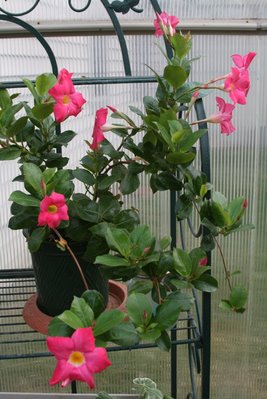
I lit the pilot and cranked the heater up to six. I prayed. Although there was a slight scent of green leaves dying on the air, none of the leaves were crispy, and none were translucent--the kiss of frosty death. I prayed some more, stayed with them, like a priest at their dying bed. But I stayed calm. In previous greenhouse disasters, I've curled up in a fetal position and howled. Not this time. I knew somehow my friends would be all right. I felt as if someone had his hand on my shoulder, though I was alone. Dad? Old Man Winter? God? I don't know. But someone helped me and my beloved plants. It almost felt like all that love defied the frost.
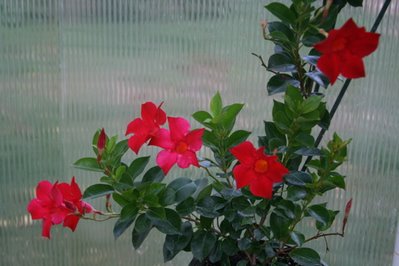 Red Satin mandevilla, proudly grown from a tiny cutting last winter. I let the mother plant, 15' high, die in December, clinging to the house in a freezing wind, knowing I had her children inside.
Red Satin mandevilla, proudly grown from a tiny cutting last winter. I let the mother plant, 15' high, die in December, clinging to the house in a freezing wind, knowing I had her children inside.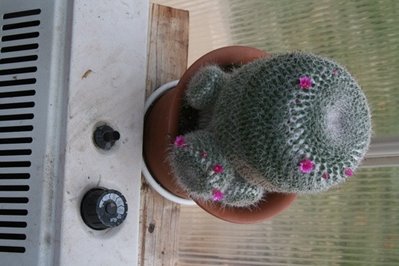 I've had this Mammilaria cactus for 16 years. It blooms all year 'round. And it loves living atop the little gas heater in the greenhouse. Can't think of another plant that would appreciate furnace-like heat. Every plant has its niche. Sorry about the photo's orientation. Sumpin' happened in iPhoto. May have to do with the 13,000-plus photos I've dumped there...must delete, must delete, can't delete. Must.
I've had this Mammilaria cactus for 16 years. It blooms all year 'round. And it loves living atop the little gas heater in the greenhouse. Can't think of another plant that would appreciate furnace-like heat. Every plant has its niche. Sorry about the photo's orientation. Sumpin' happened in iPhoto. May have to do with the 13,000-plus photos I've dumped there...must delete, must delete, can't delete. Must.Throughout the morning, I kept checking on my plant friends. One abutilon wilted completely, but by 4 pm it was fine. I lost a couple of leaves on a young Vancouver Centennial geranium; a couple of shoots on a Frank Headley fancy geranium. That, my friends was it.
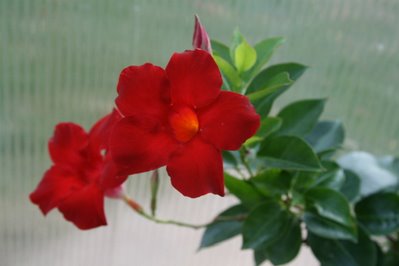 How these tropical plants survived 22 degrees, I will never know, but I trust my thermometer and my eyes and the condensed fog of breath that I saw hanging before my face in that frigid greenhouse in the predawn dark. Tonight, it's supposed to plunge back down to 8 degrees. On just such a night about five years ago, before I converted the Pod to gas heat, I lost everything, including 28 varieties of miniature geraniums, when the electricity cut off. You can be sure I'll wake a few more times tonight, to smooth a brow and give medicine, to arrange covers, and to listen for the whirr of the furnace, doing its job. I look like holy hell these days, hair sticking up like Clay Aiken's, huge dark circles under my eyes, but my poor sick coughing kids are on the mend, and my greenhouse is still growing and thriving, and that's something to keep a hopeful old girl going.
How these tropical plants survived 22 degrees, I will never know, but I trust my thermometer and my eyes and the condensed fog of breath that I saw hanging before my face in that frigid greenhouse in the predawn dark. Tonight, it's supposed to plunge back down to 8 degrees. On just such a night about five years ago, before I converted the Pod to gas heat, I lost everything, including 28 varieties of miniature geraniums, when the electricity cut off. You can be sure I'll wake a few more times tonight, to smooth a brow and give medicine, to arrange covers, and to listen for the whirr of the furnace, doing its job. I look like holy hell these days, hair sticking up like Clay Aiken's, huge dark circles under my eyes, but my poor sick coughing kids are on the mend, and my greenhouse is still growing and thriving, and that's something to keep a hopeful old girl going.Labels: bougainvillea, free gas heat, freezing plants, greenhouse, mammilaria cactus, Mandevilla

